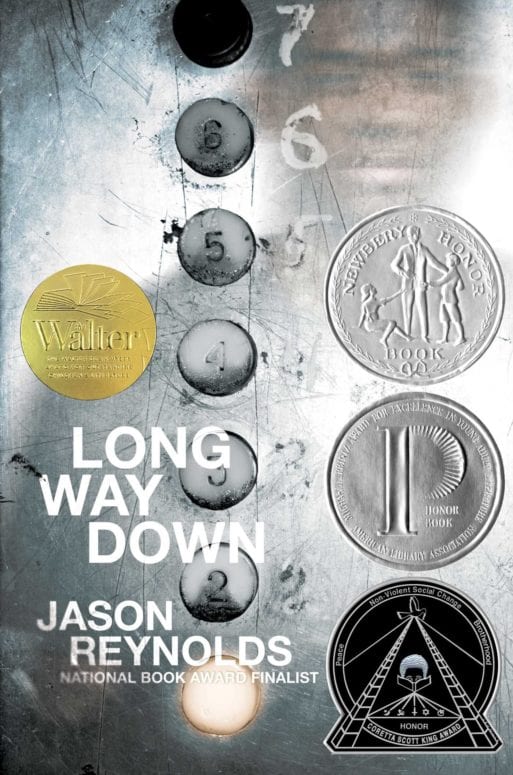
“Long Way Down” by Jason Reynolds
2017, Simon and Schuster
I SWEAR SOMETIMES
it feels like God be flashing photos of his children, awkward, amazing, tucked in his wallet for the world to see. But the world don’t wanna see no kids, and God ain’t no pushy parent so he just folds and snaps us shut.
“Long Way Down,” the 2017 YA novel in free verse by Jason Reynolds, features a 15-year- old protagonist, William Holloman, who just saw his older brother shot the day before. This very raw and emotional novel covers what happens after. What will Will do now that his brother, like so many others Will has known, has been shot and killed?
The Rules: #1 No Crying
I FELT LIKE CRYING,
which felt like
another person
trapped behind my facetiny fists punching
the backs of my eyes
feet kicking
my throat at the spot
where the swallow starts.Stay put, I whispered to him.
Stay strong, I whispered to me.Because crying
is againstThe
Rules
Will is not allowed to mourn his brother’s death because crying is against the rules. He attempts to disassociate with his pain by imagining another person trapped inside of him. It’s the other that wants to cry, not him. Not taking the time to grieve the closest person to him is what psychologists call repressive coping — keeping difficult feelings inside. The author, Jason Reynolds, reveals just how harmful this practice can be. Crying, according to Harvard Health, is medically beneficial and helps us to release stress and emotional pain. However, Will’s harsh environment makes no room for boys to cry.
The Rules: #2 No Snitching
Don’t.
No matter what.
Don’t.
Will’s neighborhood is a place where people are used to running, ducking, hiding and tucking themselves tight when they hear shots. They are not interested in sharing their thoughts on the crime or who’s responsible when it’s all over.
Cops flashed lights in our faces
and we all turned to stone.Did anyone see anything?
a young officer asked.
[…]
I ‘aint seen nothin’,
Marcus Andrews, the neighborhood
know-it-all, said.Even he knew better than to
know anything.
The Rules: #3 Revenge
If someone you love
gets killed,find the person
who killedthem and
kill them
This is the final rule and the one that Will’s story revolves around for the bulk of Reynolds’ novel. The morning after his brother Shawn is killed, Will finds Shawn’s gun and makes a plan to get the kid he believes shot Shawn. However, he lives on the eighth floor of an apartment building, and that means it’s a long way down to the lobby. Reynolds writes a trip down the elevator that changes the course of Will’s life.

Jason Reynolds
Credit: Nate B.
How Many People Can Fit In This Thing?
As Will rides the elevator, his brother’s gun tucked in the back of his jeans, a new person gets on at every floor. He is confronted by the ghosts of those he knew (and one he didn’t) who also succumbed to gun violence. He sees his brother’s mentor, his childhood friend killed in a drive-by, his uncle, his father, the boy his brother killed (also in revenge) and finally his brother, Shawn.
Each ghost talks about their own experience with guns and death, each wondering what Will intends to do with the not-so-well-hidden gun. Will isn’t able to answer any of them clearly — he’s just following the rules as his brother taught him to do. However, even 15-year-old Will knows,
ANOTHER THING ABOUT THE RULES
They weren’t meant to be broken.
they were meant for the brokento follow.
His environment is broken, full of broken people. The pain of losing someone you love is only compounded by the violent nature of the death. In Will’s world, the way to deal with the pain is not to release it through tears or words, but to inflict pain immediately on the culprit. The power of swift and righteous justice cannot be understated, but when the justice is served by those who are hurting, the cycle of violence never ends.
What Do We Do with the Pain?
Jason Reynolds’ “Long Way Down” gives its young readers an alternative to the Rules that Will believes he must follow. During that paranormal elevator ride, Will does cry, not only for Shawn but for his other lost friends and family, too. He is given the time and space to miss these people ripped from his life.
He also tells everyone he talks to who he thinks killed Shawn. At least, he thinks that’s who killed Shawn. By the third or fourth time he tells the story, he’s not so sure. Learning more about his own father’s violent past and how he took revenge for the killing of his older brother, just as Will feels compelled to do, he realizes his father shot the wrong man. This revelation provides enough doubt to make Will wonder if any of these Rules make sense.
At the end, just before reaching the lobby, Shawn — the only one Will truly wanted to see — gets on the elevator. He doesn’t speak to Will, doesn’t answer any of the questions that Will asks, doesn’t tell him what to do. Once the elevator dings open on the first floor, the ghosts of Will’s past leave and Shawn finally speaks. He asks Will, “Are you coming?”
Readers are left to decide what Will should do. By the time they reach the ground level, Reynolds has shown that choosing not to process the pain only destroys those who are hurting. Teenagers are encouraged to work through their feelings and talk them out. “Long Way Down” shows readers that revenge, even if desired, will not solve any problems and only adds to the pain of the community. One act of revenge begets another, and that cycle never brings healing.
This YA novel is a great book for any teenagers and lovers of young adult literature. It has recently been turned into a graphic novel, and a film is in the works with John Legend serving as producer.

 “Long Way Down” by Jason Reynolds
“Long Way Down” by Jason Reynolds


 Recovering Cremation Remains After the Los Angeles Fires
Recovering Cremation Remains After the Los Angeles Fires
 “As Tears Go By” by Marianne Faithfull
“As Tears Go By” by Marianne Faithfull
















